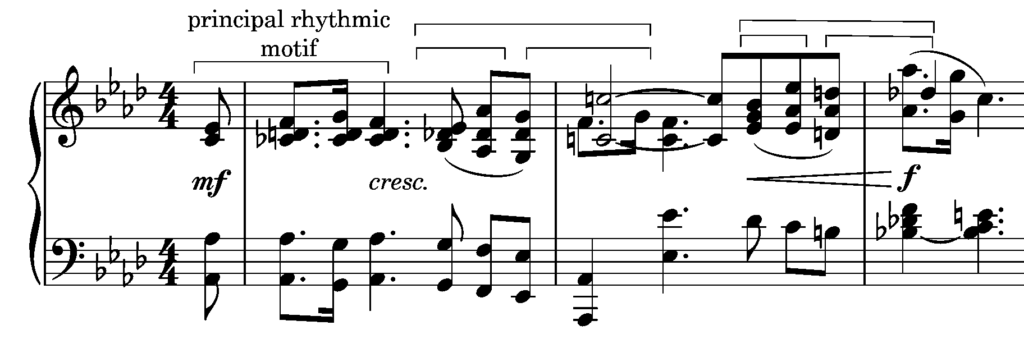We begin our survey of Chaminade’s diploma-level piano works with the middle movement of her only piano sonata. Published in 1895, it is dedicated to Moritz Moszkowski, Chaminade’s brother-in-law. Marcia J. Citron cites a performance of the first movement given two years before the work was published by the composer herself in St. James’s Hall, London, on June 1st, 1893, while the third movement is the same as Appassionato, op. 35 no. 4, which was published with the other Études de concert in 1886. The earlier opus number implies composition in the late 1870s or early 1880s, as other works from that time were also not published until the 1890s or later. (Her Pastorale enfantine, op. 12, for instance, was published in 1897, and her ‘fantaisie très facile pour un seul piano à 8 mains’, Les noces d’argent, also bizarrely given the opus number 12 was published by Enoch in 1892, and a version for piano solo in 1907.) At the early stages in her compositional career, it is perhaps understandable that she should want to present only her best and most recent work for publication, and thus public scrutiny, and only later revisit juvenilia when her public and professional reputation was more firmly established. Still, the wholescale repurposing of the final movement of a piano sonata, a significant and serious compositional endeavour, perhaps suggests that, at least by the mid-1880s, Chaminade had no intention of publishing it. It may be that a favorable response to her performance (or possibly performances) of the first movement in the early 1890s changed her mind.

Although there doesn’t appear to be any record of her playing the second and third movements in public, Chaminade’s public performance of the first movement alone, and her re-use of the finale, implies that she was comfortable with the practice of excerpting sonata movements, so we should feel no qualms about giving the other movements the same treatment.
This is a beguiling movement, which certainly repays the modest effort required to learn it. Like most of Chaminade’s so-called ‘salon pieces’, it is at least ostensibly in ternary form. The A-section is in A♭—in terms of the sonata to which it belongs, the submediant (a pattern it shares with two of Beethoven’s sonatas in the same key, op. 10 no. 1 and op. 13). The B-section is in B major (enharmonically the flat mediant of A♭) and although the transition into and out of the B-section is effected by the same simple means (a chromatic figure in sixths), A- and B-sections share some thematic material, displaying an awareness of the high-minded nature of the nineteenth-century piano sonata. Stylistically there is a wonderfully nostalgic atmosphere; the chromatically-tinged harmony and melody-dominated homophony in the outer sections remind me of Ireland, or earlier Bridge, while the use of a restricted rhythmic vocabulary and the more imitative texture of the B-section seem reminiscent of Schumann.
Analytical commentary
The 118-bar movement falls broadly into ternary form, whose boundaries are defined by a modulation from the conventional dominant area to the flattened mediant, and then back again. (Interestingly, this local modulation from the dominant, E♭, to its flat submediant, C♭ (written enharmonically as B major), reflects the key-relationship between this movement and those which surround it in the sonata.
| A | bb. 1-39 | A♭ major | 36bb + 3bb bridge | ||
| bb. 1-7 | A♭ major | A1 | |||
| bb. 8-15 | C minor | B | |||
| bb. 16-24 | A♭ major | A2 | bb. 16-19 = bb. 1-4bb. 20-22, sequential extension + 2bb. codetta | ||
| bb. 25-36 | C | 5bb. + 6bb. | |||
| bb. 37-39 | E♭ major | bridge | based on main rhythmic motif, chromatic inflection | ||
| B | bb. 40-83 | (C♭=) B major | |||
| bb. 40-51 | B major | D1 | Two repeated six-bar phrases,bb. 40-45 moving towards D♯ minor,bb. 46-51 moving to half close in F♯ minor | ||
| bb. 52-56 | F♯ major | C | First (5bb.) phrase | ||
| bb. 57-67 | B major | D2 | repeat of bb. 40-51, slightly elaboratediv-Ic-V in F♯ minor (b. 51) omitted | ||
| bb. 68-74 | B major | E | free sequential material2+2+3 bb. over dominant pedalfinal phrase recalling idea of D1 | ||
| bb. 75-80 | B major | C | Second (6bb.) phrase | ||
| bb. 81-83 | E♭ major | bridge | bb. 37-39 | ||
| A | bb. 84-106 | A♭ major | repeat of bb. 1-23 | ||
| CODA | bb. 107-118 | A♭ major | based on B, 12bb. tonic pedal |
The first 23-bar paragraph divides into a ternary form of its own. (This structural procedure is typical of Chaminade’s works—see, for instance, the First Arabesque, op. 60.)
The first four bars (see ex. 1) present the material from which most of the A-section is derived. A dotted-rhythm motif, essentially a diminished-seventh chord on the tonic, momentarily decorated by upper and lower auxiliary notes in the soprano and bass, is followed by two ascending fourths which are harmonised IVb-V7-I6. This opening phrase is answered by a phrase built on rising and falling fifths. Note the rhythmic unity of the entire phrase: just two motifs persist throughout.

Bars 5-7 dovetail the close of the opening phrase and a chromatic ascending sequence (also featuring the rising fourth) which terminates on another diminished seventh, this time on the dominant.
Bars 8-15 make a B-section in C minor (see ex. 2), which nonetheless initially gravitates towards the subdominant of that key; until the assertive drone bass, which appears in b. 12, confirms the key, as do repeated statements of the tonic chord. Note the use of the opening rhythmic pattern—but now displaced by a beat, making the dotted rhythm an anacrusis—with a very different expressive quality. The retransition to the A-section material—simply omitting the dominant of the C-minor chord and reharmonising the E♭ and C with A♭—is, admittedly, a tad clunky.

Bars 16-19 are a literal repeat of bars 1-4, with just a slight alteration at the end of bar 19 to keep the music in the tonic for a three-bar sequence, heavy on plagal seasoning, closing via a vi-ii7-IV/V-V7-I progression.
Bars 25-36 consists of a 5-bar phrase, which is repeated and extended by a bar and taken in a new harmonic direction. This passage develops the opening dotted-rhythm motif, in a new harmonic context and a higher register and with a lighter texture (see ex. 3). Where the opening paragraph emphasised ambiguity and instability—with diminished-seventh chords and chromatic part-writing—this section revels in the tonic, established by means of repeated imperfect and plagal cadences punctuated by rising fourth-based chords over a tonic pedal.

After returning to the register and voicing of the opening, the music modulates to the dominant, and a three-bar codetta recalls the dotted-rhythm motif over a chromatic rising and falling idea in sixths (see ex. 4).

The B-section is rather Schumannesque in terms of its imitative texture and melodic lyricism (see ex. 5). It is notable for avoidance of the tonic, which features only occasionally in harmonic progressions moving elsewhere, and rarely in root position. As the duet between soprano and tenor develops the music is pushed towards D♯ minor, where it briefly settles at bar 45 before the process begins again, turning through parallel minor to a half-close in F♯ minor.

In a constructional masterstroke, the material from the A-section’s C-section returns, now in dominant major. This brings the A- and B-sections into alignment, in that both begin with passages of more turbulent, searching chromatic harmony, which are then followed by this almost serene passage of radiantly stable triadic harmony. This version of the paragraph is truncated, however, ending after four bars with a perfect cadence in the dominant.
This immediately gives way to a slightly altered repeat of bars 40-50 (bars 57-67), the music this time avoiding the final turn to F♯ minor, F♯ functioning as a dominant pedal throughout a climactic seven-bar phrase which subsides with one final reminiscent soprano-tenor exchange of the B-section’s principal melodic idea before the C-theme returns in the local tonic. The section concludes with a three-bar bridge passage—B, now enharmonically becoming the flattened submediant of E♭—based again on the chromatic-scalic idea in sixths.
The reprise of the A-section (bars 84-106) is, the slightly different opening aside, a literal repeat of bars 1-23. The B-section theme interrupts proceedings at b. 107 (see ex. 6), however, the harmony here oscillating between I7 and IVc. The tonic pedal remains until one final perfect cadence at bars 116-17 brings the scene to a calm conclusion.

I hope this brief discussion shows that, although it is not inaccurate, to describe this movement as a simple ternary form does not do justice to the relationship between the material and the tonal shape of the movement. The rhythmic unity, as well as the ‘through-composed’ sense, of this movement shows a more sophisticated approach to form than many of Chaminade’s single-movement miniatures. Given the thoughtful structural integration demonstrated in this early essay, it is to be regretted that the composer never made subsequent forays into the more ‘serious’ world of the piano sonata.
Performance Issues
There is little here that a student should find overly taxing. Well-voiced chord playing, and careful legato-pedalling are required, along with sensitivity to the B-section’s imitative texture. Musical interest will derive from imaginative ‘orchestration’ and varied tone-colour. Don’t shy away from use of the una corda pedal, and not just for the softest passages. The contact between the less-densely compacted hammer surfaces and the strings results in a gentler attack, not just a quieter dynamic—just as a muted brass or string instrument can play at varying dynamics—so, too, the una corda offers us a different tonal palette at a range of tonal levels.
The C-theme’s right-hand arpeggios can be taken consistently with a 1-2-3-4-1-2-3-4-5 fingering (see ex. 7). I would advise against adopting varying fingerings for each chord; although graded-exam fingering patterns are often designed to provide ergonomic solutions to the specific problems posed by scales and arpeggios in the various keys, it is a fact of life that advanced pianists must be comfortable playing with our outside digits on black keys. In this case, in the second set of arpeggios the fourth finger will land on Bs, and second and fourth fingers will land on Bs and Es respectively in the final iteration. With a supple hand and wrist I believe the consistency will outweigh these mechanical inconveniences.

A comfortable octave span is essential—there are some tenths, but most can be spread, even when not marked, or even redistributed. There is, for example, no reason for the tenor A♯ in the first chord in bar 56 not to be taken by the right hand, nor the tenor B in the first chord in bar 58. Likewise the last two alto notes in bar 69 can be taken with the left hand; the leap from the octave F♯s in the bass is fairly acrobatic, but perhaps still preferable to breaking the right-hand stretch. This is not an exhaustive list—but bear in mind that Chaminade doesn’t use the treble- and bass-clef staves to allocate notes to the right and left hands respectively. Rather, the hands move freely between staves in preference to frequent changes of clef. Bars 9-12 require clef-changes in the lower stave—there is no better alternative in this circumstance—but by and large the staves retain their ‘standard’ cleffing and the hands move between them. (The give-away is empty staves without rests; the hand in question must be doing something on the other stave!) In performance it is more important to adhere to the spirit of the musical product than to follow the letter of its notation, so feel free to explore creative solutions to the more widely-spaced chords. (Bar 107 offers a concrete example of one such solution, which could be applied elsewhere)
An instance such at the left-hand acciaccatura in bar 108 would seem to imply, by the absence of the same device elsewhere, that if you plan to use a similar approach to chords that are too wide to be taken in one go, the lowest note should coincide with the right hand, rather than being placed before everything else. There is little reason for the notation in bar 108 unless it is an exceptional circumstance. This, obviously, would not apply to ‘harped’ chords across the entire grand stave, but in the case where the arpeggio is restricted to one stave or the other, again, perhaps the bottom note of the spread chord should be placed on the beat.
I would recommend a considered approach to tempo. This is a danger area as inconsistency will result in a rendition that sounds diffuse. The overall Andante should not, in my opinion, be sluggish—andante means ‘going’!—and although the B-section is more flowing, with more regular phrasing and more consistent quaver motion, it is not given a different tempo marking, so the performer must find a ‘baseline’ tempo at which both sections work effectively. The frequent animato instructions should also be moderated. Every one of them coincides with a crescendo, so if an acceleration is required to convey a more animated feeling, I would reserve it until the peak of the crescendo. None of the animato markings is followed immediately by an a tempo, which only occur after poco rit., rit., or rall., so there is nothing to imply that Chaminade intended animato specifically to mean ‘faster’. Each of the ‘slower’ markings, on the other hand, coincides with a diminuendo, so the player must decide: do these markings convey a drop below baseline tempo, and the a tempo markings a return to it? Or do animato+crescendo and rit.+diminuendo balance each other, the a tempo confirming the resumption of the baseline tempo?
Note the consistent distinction between rit. and rall. markings. Rallentando can only be interpreted as a gradual deceleration, but rit.—an abbreviation of either ritenuto (immediately slower) or ritardando (synonymous with rallentando)—could be either. There is only one rall. here (in bar 71), but its presence implies that Chaminade intends the various rit. markings to mean ritenuto, not ritardando.
Tellingly, the final page indicates no change of tempo, and I think this is the interpretative clue to the tempo puzzle. No performance of music from any era (some twentieth-century music being an exception) should be rigid, because it lacks breath and, ultimately, that breath is what gives the performance humanity. But consistency is not rigidity; a subtle capacity for flexibility in phrasing, a sense of musical punctuation, is just as vital a component of musicianship as a solid sense of pulse. This is not a license to be wayward, however, as this waywardness turns charm and sensitivity into mannerism and sentimentality. These are charges often levelled at composers of so-called ‘salon music’ (in which category much of Chaminade’s output resides). Often, however, the guilty party is not the composer, but rather the overly indulgent performer. To do justice to the economy and integrity of the compositional structure, aim for a performance that is similarly organised and intelligent.

